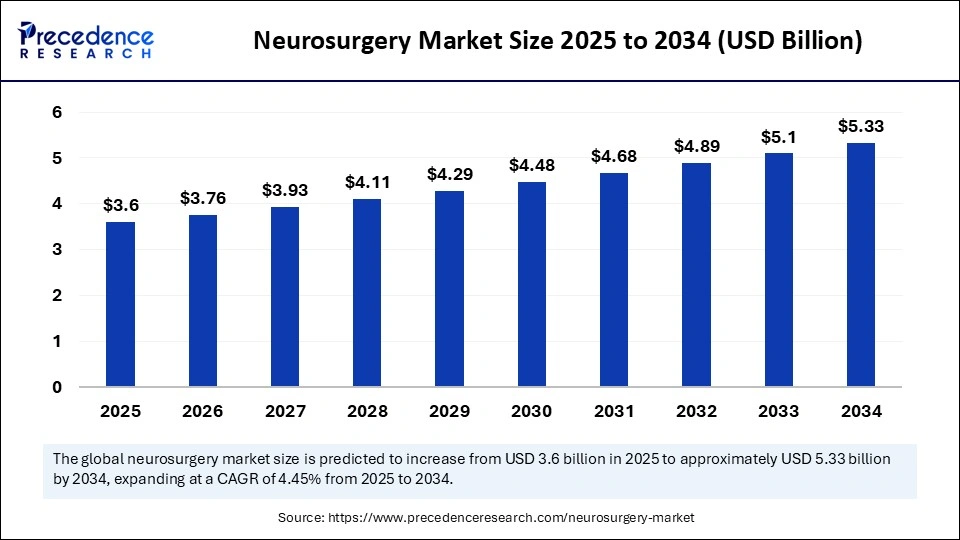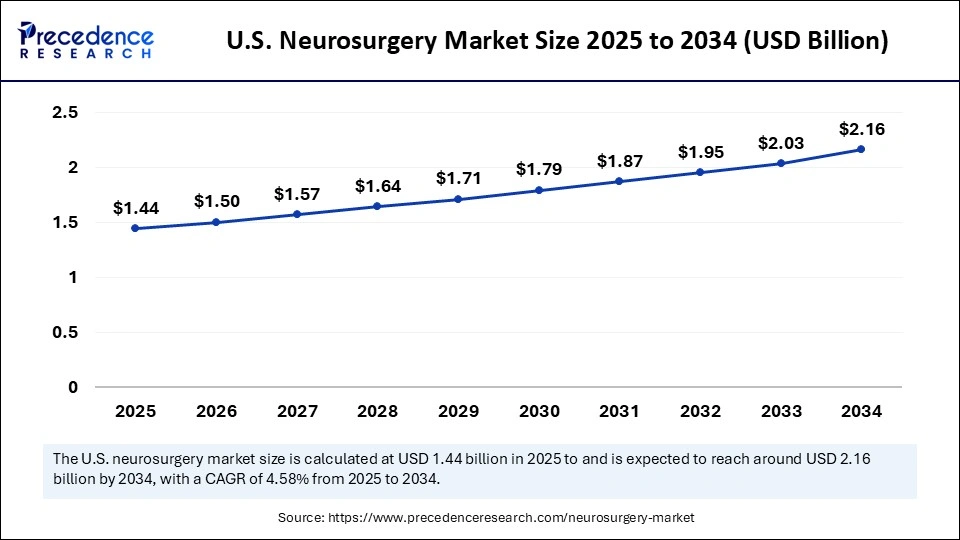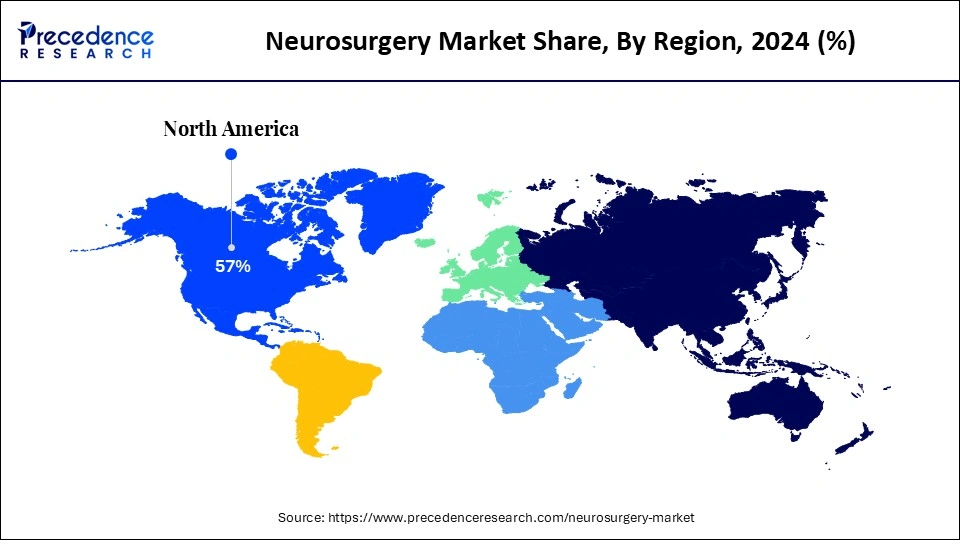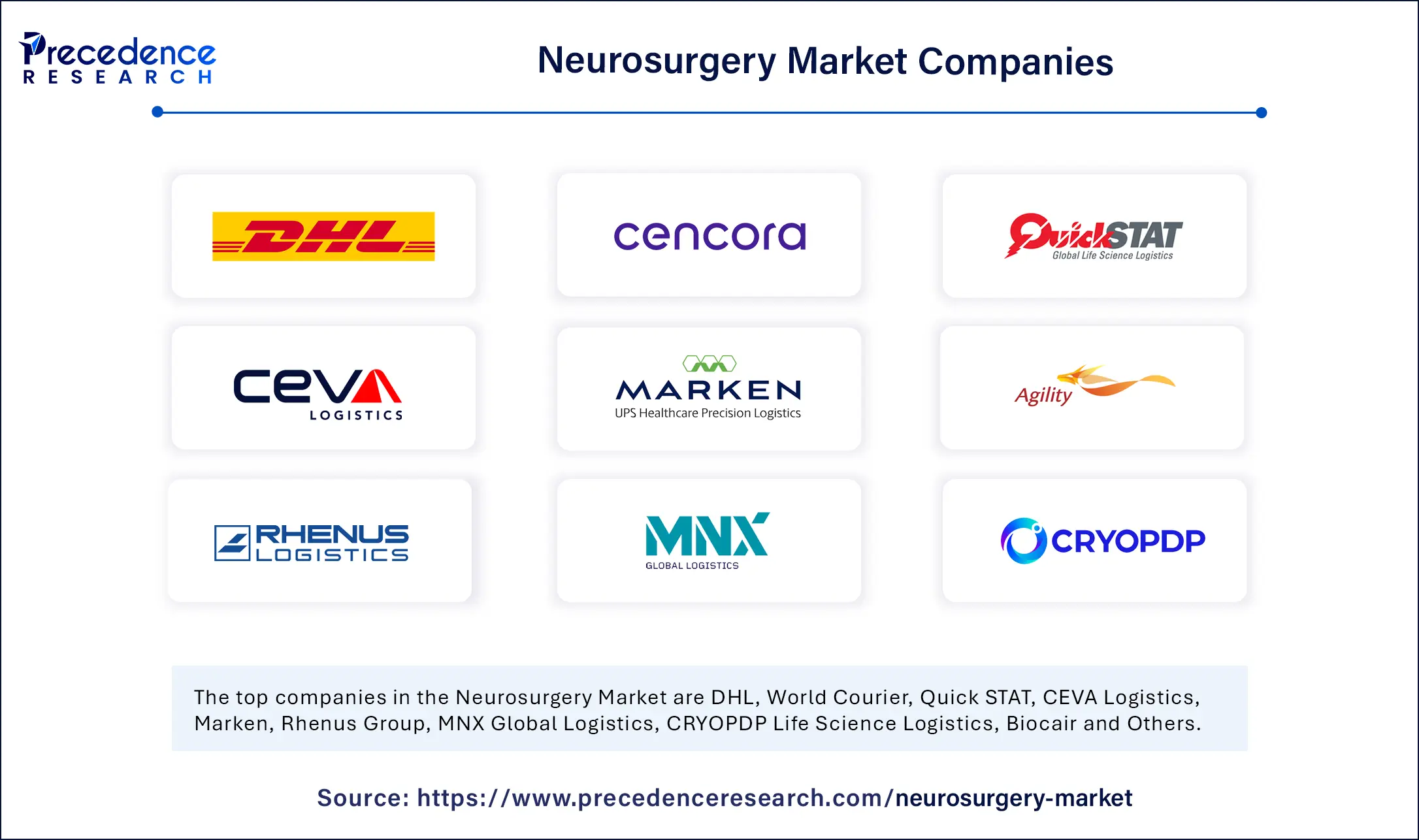List of Contents
Neurosurgery Market Size and Forecast 2025 to 2034
The global neurosurgery market size accounted for USD 3.45 billion in 2024 and is predicted to increase from USD 3.6 billion in 2025 to approximately USD 5.33 billion by 2034, expanding at a CAGR of 4.45% from 2025 to 2034. The increasing incidence of neurological disorders, adoption of sophisticated surgical instruments, and demand for minimally invasive procedures are boosting the growth of the market.

Neurosurgery MarketKey Takeaways
- The neurosurgery market was valued at USD 3.45 billion in 2024.
- It is projected to reach USD 5.33 billion by 2034.
- The market is expected to grow at a CAGR of 4.45% from 2025 to 2034.
- North America led the neurosurgery market with the highest share of 57% in 2024.
- Asia Pacific is expected to expand at the fastest CAGR between 2025 and 2034.
- By product type, the neuroendoscopes segment held the largest market share in 2024.
- By product type, the radiosurgery systems segment is expected to grow at a significant CAGR between 2025 and 2034.
- By indication type, the brain cancer segment captured the biggest market share in 2024.
- By indication type, the traumatic brain injuries segment is expected to expand at the highest CAGR over the projected period.
- By end-user, the hospital and specialty clinics segment contributed the highest market share in 2024.
- By end-user, the ambulatory surgical centers segment is expected to expand at the fastest CAGR during the forecast period.
AI-Powered Neurosurgery: Opening New Fronts for Precision and Personalized Medicine
The use of artificial intelligence (AI), machine learning, and augmented reality (AR) in neurosurgery is revolutionizing the market. AI helps in real-time interventional decision-making, improves diagnostic accuracy, and minimizes intraoperative risks, especially in minimally invasive procedures. AI-driven robotic systems, like Synaptive Medical's Modus V and Zimmer Biomet's ROSA One, are elevating precision in neurosurgery. Robotic systems assist with navigation, provide visual fidelity, and increase the body's capability to perform microsurgical tasks by reducing trauma and improving recovery rates. Additionally, AI is becoming a strategic investment in surgical simulation and training, offering scalable options in education and skill development.
U.S. Neurosurgery Market Size and Growth 2025 to 2034
The U.S. neurosurgery market size was exhibited at USD 1.38 billion in 2024 and is projected to be worth around USD 2.16 billion by 2034, growing at a CAGR of 4.58% from 2025 to 2034.

What Made North America the Dominant Region in the Neurosurgery Market?
North America registered dominance in the market by holding the largest share in 2024. This is mainly due to its robust healthcare infrastructure, early adoption of advanced surgical technologies, and the increased number of patients with neurological disorders. There is a high demand for minimally invasive neurosurgical procedures. The availability of advanced healthcare facilities and government support for the research and development of neurotechnology further bolstered the growth of the market in the region. According to the American Association of Neurological Surgeons (AANS), the number of neurosurgical procedures performed over the last few years has gradually increased in North America, creating the need for sophisticated neurosurgery equipment.
The U.S. plays a major role in the North American neurosurgery market. The U.S. boasts well-developed hospitals and medical device manufacturers. There is a significant increase in funding for neurological research in the U.S. through the National Institutes of Health (NIH) and BRAIN Initiative in hopes of improving the diagnosis and treatment of brain disorders. Hospitals, like the Mayo Clinic and Cleveland Clinic, have also recently started the implementation of AI-driven diagnostic and surgical equipment to improve precision and patient outcomes.
( Source: https://www.thetransmitter.org)

Asia Pacific Neurosurgery Market Trends
Asia Pacific is expected to grow at the fastest CAGR in the coming years, driven by increasing healthcare investments, improving hospital infrastructure, and a rising burden of neurological disorders. Countries like India and China are experiencing a surge in demand for advanced neurosurgical solutions due to the increased burden of neurological conditions, aging demographics, and improved access to specialized care. China is emerging as the leading market, driven by government initiatives like "Healthy China 2030" and growing medical tourism. The expansion of neurology departments in Tier 1 and Tier 2 cities, alongside investments in training neurosurgeons and acquiring advanced systems such as robotic drills and navigation systems, is transforming the neurosurgical landscape in the region. Additionally, domestic medical device manufacturers are introducing more efficient and safer neurosurgical equipment to gain a competitive edge.
- In March 2025, Brain Navi Biotechnology announced a strategic partnership with BenQ Medical Technology to introduce and commercialize Brain Navi's NaoTrac neurosurgical navigation robot in the Chinese market. Brain Navi's cutting-edge, artificial intelligence (AI)-powered NaoTrac navigation system will play a “crucial role” in enhancing patient outcomes in neurosurgery.
(Source: https://neuronewsinternational.com)
European Neurosurgery Market Trends
Europe is expected to grow at a significant rate during the forecast period, driven by an aging population and ongoing upgrades in technologies for neurosurgery. The region boasts advanced healthcare systems, contributing to regional market growth. Rising government programs that promote early diagnoses and surgical interventions for neurological conditions and a strong emphasis on research and development further support market growth. Germany is a major player in the market because of its vast hospital network, early adoption of image-guided surgery, and the availability of skilled neurosurgeons. The presence of specialized clinics and the growing number of brain and spinal surgeries are also supporting market growth.
Market Overview
The neurosurgery market is one of the major fields in the healthcare sector containing approaches that diagnose, treat, and surgically manage conditions of the nervous system (i.e. brain, spinal cord, and peripheral nerves). The market encompasses the full range of devices and services, including surgical instruments, neurosurgical navigation systems, implants, and neuroendoscopy devices, used in procedures such as tumor removal, spinal surgeries, and management of traumatic brain injury. The market is growing steadily due to the increased prevalence of neurological disorders, the increased use of minimally invasive surgical techniques, and the increased availability of imaging and navigation systems. In addition, the aging population is more likely to have neurological disorders or a high risk of developing neurological conditions is creating demand for neurosurgical procedures. Technological innovations like robotic-assisted surgery and intraoperative imaging enhance precision in neurosurgery and patient outcomes.
Neurosurgery MarketGrowth Factors
- Growing Neurological Disease Burden: The rising incidence of conditions such as brain tumors, stroke, and epilepsy is increasing the demand for neurosurgical intervention and opportunities for growth in both surgical devices and surgical interventions.
- Technological Advancements: Innovation in neurosurgical interventions and surgical tools (i.e. neuronavigation, robotic systems, and real-time imaging) are enhancing the precision of surgical procedures and improving surgical outcomes, which is increasing the overall effectiveness and adoption of neurosurgical procedures in health facilities.
- Aging Population: The expanding older population who are more likely to experience neurological disorders (i.e. Parkinson's, dementia, etc.) has increased the per capita utilization of neurosurgery, which addresses primarily degenerative spinal and brain conditions.
- Demand for Minimally Invasive Surgery: Due to accelerated recovery compared to traditional surgery, coupled with lower risk and reported postoperative pain, hospitals are increasingly inclined to accommodate patient demand for minimally invasive neurosurgery by investing in new tools that enable advanced applications of minimally invasive surgery.
Market Scope
| Report Coverage | Details |
| Market Size by 2034 | USD 5.33 Billion |
| Market Size in 2025 | USD 3.6 Billion |
| Market Size in 2024 | USD 3.45 Billion |
| Market Growth Rate from 2025 to 2034 | CAGR of 4.45% |
| Dominating Region | North America |
| Fastest Growing Region | Asia Pacific |
| Base Year | 2024 |
| Forecast Period | 2025 to 2034 |
| Segments Covered | Product Type, Indication Type, End User, and Region |
| Regions Covered | North America, Europe, Asia-Pacific, Latin America, and Middle East & Africa |
Market Dynamics
Drivers
Increasing Cases of Neurological Disorders
A major factor driving the growth of the neurosurgery market is the rising number of cases of neurological disorders, including brain tumors, Parkinson's disease, epilepsy, stroke, and traumatic brain injuries. According to the World Health Organization's (WHO) 2024 Report, neurological disorders are responsible for more than 9 million deaths per year. This is the second leading cause of death in the world. As per the Centers for Disease Control and Prevention (CDC), every year, about 50,000 people die from a traumatic brain injury (TBI) in the U.S. At least 5.3 million Americans live with long-term disabilities related to TBI. This highlights the increased demand for neurosurgery. In addition, advancements in neuroimaging, intraoperative navigation, and robotic-assisted technologies make neurosurgical operations less invasive, more accurate, and safer, facilitating better outcomes for patients and lower recovery time. As awareness and diagnosis increase, patients are increasingly opting for surgical treatment.
(Source: https://www.who.int)
(Source: https://pubmed.ncbi.nlm.nih.gov)
Restraint
High Treatment Cost
A significant restraining factor in the neurosurgery market is the high costs associated with surgical procedures, along with the global shortage of trained neurosurgeons. Neurosurgical treatments, especially for complex problems such as brain tumors or spinal cord injuries, often require sophisticated instrumentation, longer hospital stays, and intensive recovery and aftercare, which increase overall treatment costs. The mean cost of different procedures ranged from US$ 291 for burr hole evacuations to US$ 1,221 for excision of brain tumors. These high price points mean many people lack access to neurosurgical care, especially in low- and middle-income countries. In 2024, the World Federation of Neurosurgical Societies (WFNS) reported that nearly 5 billion people do not have access to timely and safe neurosurgical services due to the shortage of trained neurosurgeons. It also reported that 26.8% of LMICs lack access to vital neurosurgical equipment.
(Source: https://pubmed.ncbi.nlm.nih.gov)
Opportunity
Increase in Older Population
The burgeoning older population is creating a significant opportunity for the neurosurgery market. Aging greatly increases the risk for neurological disease, including Alzheimer's disease and Parkinson's, spinal degeneration, brain tumors, and others that often require surgical intervention. The WHO reported that the number and proportion of people aged 60 years and older is increasing. In 2019, the number of people aged 60 years and older was 1 billion. This number will increase to 1.4 billion by 2030 and 2.1 billion by 2050. Most significantly, the numbers will grow in size most dramatically in Asia and Europe.
(Source:https://www.who.int)
This major demographic shift is likely to increase the demand for surgeons performing age-related procedures, especially spinal decompressions, deep brain stimulation (DBS), and intracranial tumor removals. Older patients are increasingly attracted to minimally invasive procedures due to their shortened recovery time and reduced complications, allowing manufacturers to develop specialized tools and implantable devices for geriatric care. As the aging population continues to increase, the healthcare system must expand more neurosurgical programs focused on elderly care.
Product Type Insights
Why did the Neuroendoscopes Segment Dominate the Market in 2024?
The neuroendoscopes segment dominated the neurosurgery market with the largest share in 2024. This is mainly due to their minimally invasive nature and better visualization in brain surgery. These tools are becoming essential for certain neurosurgical procedures, specifically ventricular tumor resections and endoscopic third ventriculostomy, as these procedures are more widely adopted worldwide. In addition, incidence rates of hydrocephalus and pituitary tumors indicate that the need for neuroendoscopy is likely to grow for its clinical benefits, and it is the least traumatic surgical intervention with the least amount of recovery time and the best results compared to the other treatment modalities. This significantly boosts the demand for neuroendoscopes.
The radiosurgery systems segment is expected to grow at a significant CAGR during the projection period because of their precision and non-invasive nature and ability to treat complex brain tumors and complex vascular malformations. The areas such as Gamma Knife and CyberKnife are gaining traction, especially given that a lot of the practices offer them as outpatient procedures, thus lowering the amount of time in the hospital, especially with high accuracy and almost no side effects. The rapid expansion with stereotactic radiosurgery, especially for the elderly and high-risk patients, and ongoing advancements, innovation, and acceptance of imaging systems and robots are supporting segmental growth.
Indication Insights
Why did the Brain Cancer Segment Dominate the Market?
The brain cancer segment dominated the neurosurgery market in 2024 because of the increased occurrence of malignant brain tumors and the pressing need for surgical management, both in terms of tumor management and patient survival. Recent technology and highly accurate neuroimaging and surgical equipment have improved the accuracy of the excision of tumors. Increased awareness and higher rates of diagnosis in developed countries have translated into a higher volume of neurosurgery procedures for patients with brain cancer.
The traumatic brain injuries (TBI) segment is expected to grow at the fastest rate in the upcoming period due to the increasing number of road accidents, sports injuries, and military-related trauma. There is an extreme need for emergency surgical management (e.g. decompressive craniectomy, hematoma evacuation, etc.) at first presentation, supporting segmental growth. Advancements in emergency neurosurgical care and improvements in trauma care capacity further contribute to segmental growth.
End-User Insights
How Does the Hospitals and Specialty Clinics Segment Dominate the Market in 2024?
The hospitals and specialty clinics segment dominated the neurosurgery market with the maximum share in 2024 due to the increased patient pool in these settings. The presence of trained neurosurgeons and advanced surgical devices encourage patients to perform surgery in these settings. These surgeries conduct both emergency and elective surgeries, including tumor resections, vascular repairs, and neuro-trauma repairs. The increased investments by the government and private sectors to improve neurosurgical capabilities in hospitals further support segmental growth. In addition, rising insurance coverage for hospital treatments attracts more patients in these settings.
The ambulatory surgical centers segment is expected to expand at the fastest rate during the forecast period. This is mainly due to the increasing preference for outpatient settings for their cost-effective care, shorter lengths of stay, and the availability of minimally invasive neurosurgical equipment. AMCs are an ideal facility for many patients as they provide cost-effective treatments than hospitals and specialty clinics. The increasing demand for personalized care and faster recovery is expected to drive the growth of the segment.
Neurosurgery Market Companies

- Abbott Laboratories
- Aleva Neurotherapeutics
- Boston Scientific Corporation
- Brainlab
- B. Barun
- Elekta
- Medtronic plc
- Wallaby Medical, LLC
- Integra LifeSciences
- Terumo Medical Corporation
Recent Developments
- In March 2025, Viseon unveiled an innovative Hubble AV system in neurosurgery. Hubble AV is a first-of-its-kind device that integrates aspiration, illumination and advanced 4K digital visualisation (4K-ADV) into a single, sterile, disposable instrument, which is redefining anatomical inspection and surgical efficiency.
(Source: https://neuronewsinternational.com) - In August 2024, RebrAIn, a pioneering precision neuro-surgery platform company, received its second FDA 510(k) clearance for its OptimMRI software, which now includes a new machine learning model to assist in targeting the infero-lateral part of the VIM for lesioning techniques such as MRgFUS and Radiosurgery. RebrAIn's software as a medical device (SaMD) is designed to revolutionize neurosurgical target planning by combining advanced AI algorithms, trained on clinical data, with MRI sequences to provide neurosurgeons with the most optimal targets for lesioning and electrode placement.
(Source: https://www.businesswire.com)
Segments Covered in the Report
By Product Type
- Neuroendoscopes
- Neurosurgical Drills
- Radiosurgery Systems
- Dura Substitutes
- Neurological Ablation Device
- Neurosurgery Instruments
By Indication Type
- Brain Cancer
- Craniofacial Trauma
- Spine and Skull Base Tumors
- Traumatic Brain Injuries
- Craniofacial Trauma
- Parkinson's Disease
- Tourette's Syndrome
- Others (Craniosynostosis, etc.)
By End-User
- Hospital and Specialty Clinics
- Ambulatory Surgical Centers
- Others (Academics and Specialized Neurological Institutes, etc.)
By Region
- North America
- Europe
- Asia-Pacific
- Latin America
- Middle East and Africa
For inquiries regarding discounts, bulk purchases, or customization requests, please contact us at sales@precedenceresearch.com
Frequently Asked Questions
Ask For Sample
No cookie-cutter, only authentic analysis – take the 1st step to become a Precedence Research client